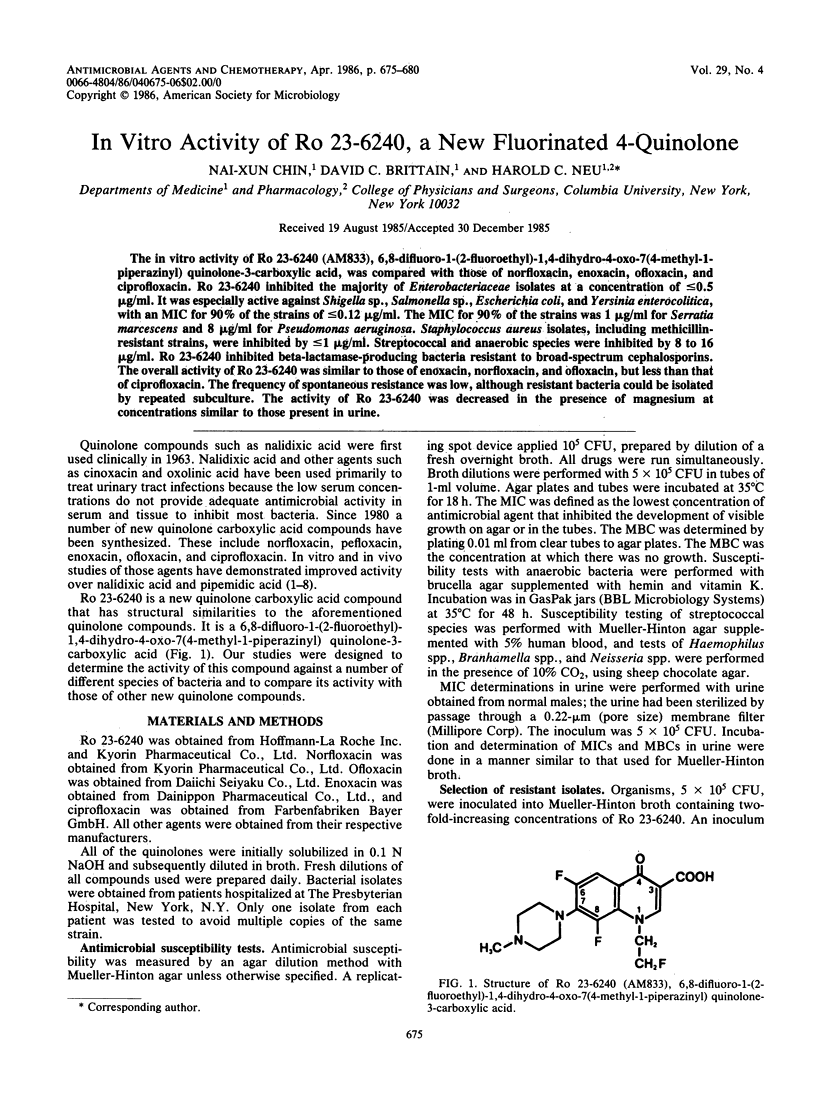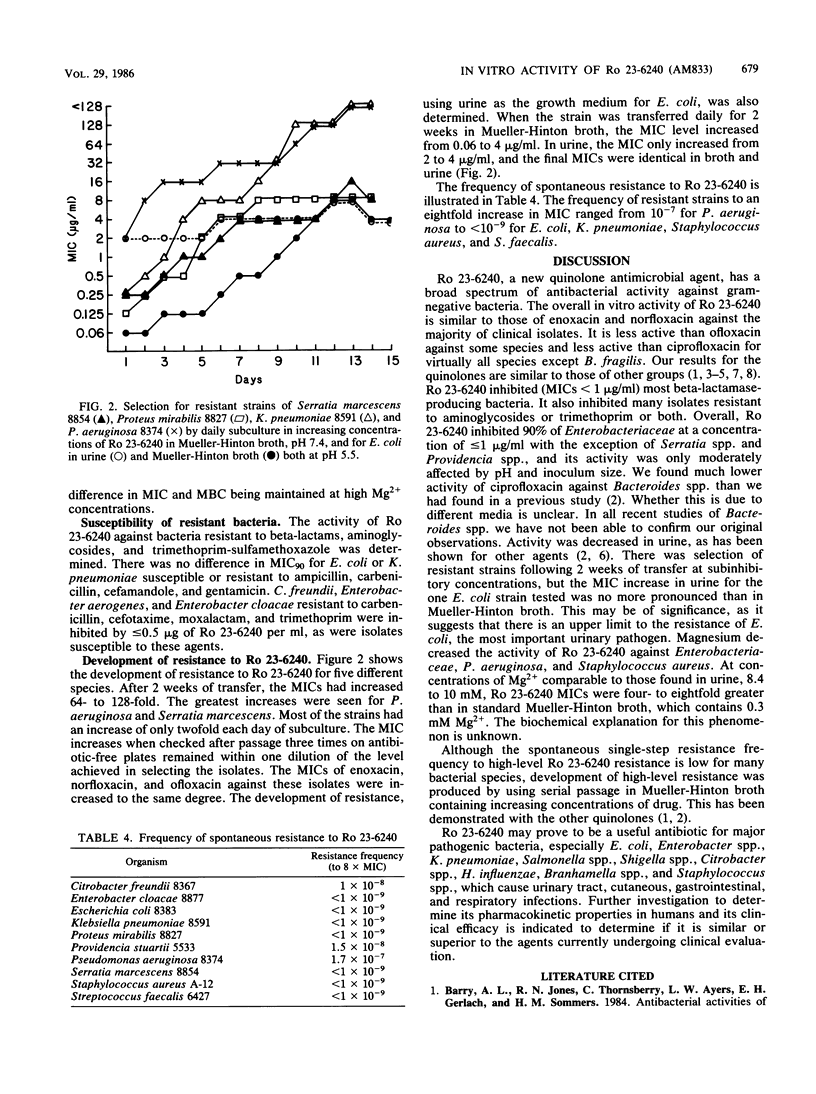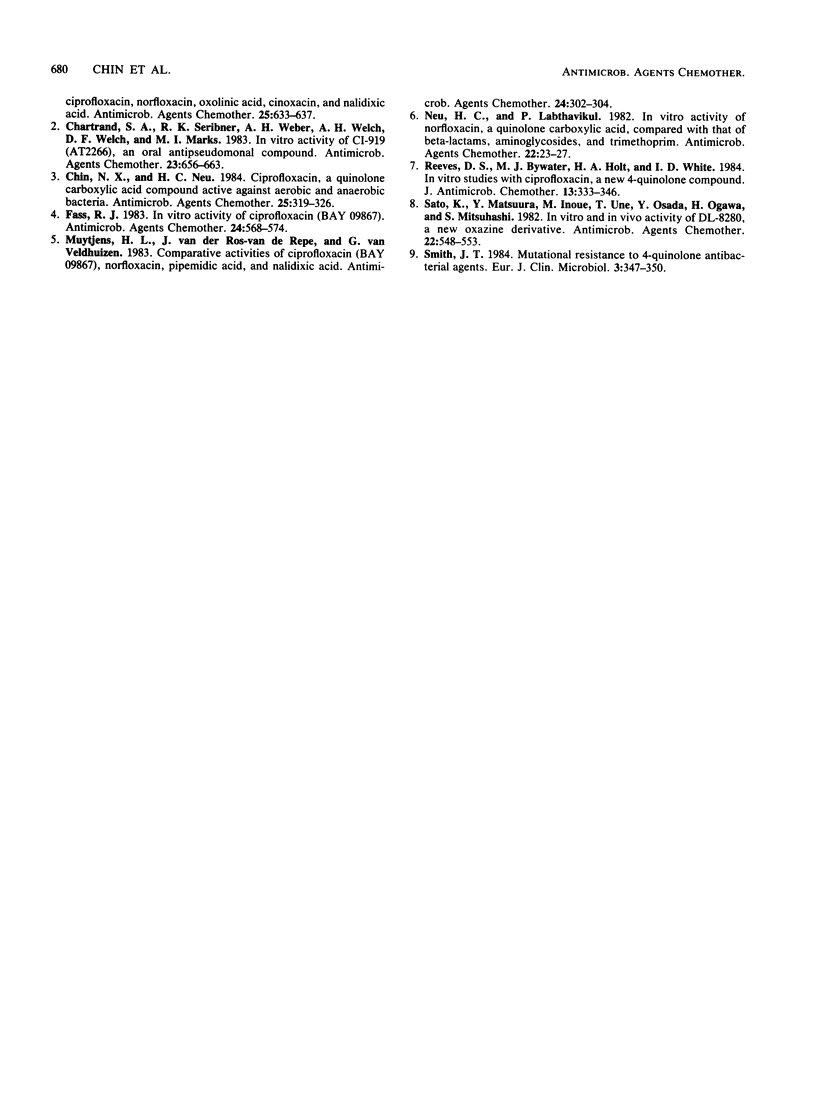Abstract
The in vitro activity of Ro 23-6240 (AM833), 6,8-difluoro-1-(2-fluoroethyl)-1,4-dihydro-4-oxo-7(4-methyl-1-piper azinyl) quinolone-3-carboxylic acid, was compared with those of norfloxacin, enoxacin, ofloxacin, and ciprofloxacin. Ro 23-6240 inhibited the majority of Enterobacteriaceae isolates at a concentration of less than or equal to 0.5 microgram/ml. It was especially active against Shigella sp., Salmonella sp., Escherichia coli, and Yersinia enterocolitica, with an MIC for 90% of the strains of less than or equal to 0.12 microgram/ml. The MIC for 90% of the strains was 1 microgram/ml for Serratia marcescens and 8 micrograms/ml for Pseudomonas aeruginosa. Staphylococcus aureus isolates, including methicillin-resistant strains, were inhibited by less than or equal to 1 microgram/ml. Streptococcal and anaerobic species were inhibited by 8 to 16 micrograms/ml. Ro 23-6240 inhibited beta-lactamase-producing bacteria resistant to broad-spectrum cephalosporins. The overall activity of Ro 23-6240 was similar to those of enoxacin, norfloxacin, and ofloxacin, but less than that of ciprofloxacin. The frequency of spontaneous resistance was low, although resistant bacteria could be isolated by repeated subculture. The activity of Ro 23-6240 was decreased in the presence of magnesium at concentrations similar to those present in urine.
Full text
PDF





Selected References
These references are in PubMed. This may not be the complete list of references from this article.
- Chartrand S. A., Scribner R. K., Weber A. H., Welch D. F., Marks M. I. In vitro activity of CI-919 (AT-2266), an oral antipseudomonal compound. Antimicrob Agents Chemother. 1983 May;23(5):658–663. doi: 10.1128/aac.23.5.658. [DOI] [PMC free article] [PubMed] [Google Scholar]
- Chin N. X., Neu H. C. Ciprofloxacin, a quinolone carboxylic acid compound active against aerobic and anaerobic bacteria. Antimicrob Agents Chemother. 1984 Mar;25(3):319–326. doi: 10.1128/aac.25.3.319. [DOI] [PMC free article] [PubMed] [Google Scholar]
- Fass R. J. In vitro activity of ciprofloxacin (Bay o 9867). Antimicrob Agents Chemother. 1983 Oct;24(4):568–574. doi: 10.1128/aac.24.4.568. [DOI] [PMC free article] [PubMed] [Google Scholar]
- Muytjens H. L., van der Ros-van de Repe J., van Veldhuizen G. Comparative activities of ciprofloxacin (Bay o 9867), norfloxacin, pipemidic acid, and nalidixic acid. Antimicrob Agents Chemother. 1983 Aug;24(2):302–304. doi: 10.1128/aac.24.2.302. [DOI] [PMC free article] [PubMed] [Google Scholar]
- Neu H. C., Labthavikul P. In vitro activity of norfloxacin, a quinolinecarboxylic acid, compared with that of beta-lactams, aminoglycosides, and trimethoprim. Antimicrob Agents Chemother. 1982 Jul;22(1):23–27. doi: 10.1128/aac.22.1.23. [DOI] [PMC free article] [PubMed] [Google Scholar]
- Reeves D. S., Bywater M. J., Holt H. A., White L. O. In-vitro studies with ciprofloxacin, a new 4-quinolone compound. J Antimicrob Chemother. 1984 Apr;13(4):333–346. doi: 10.1093/jac/13.4.333. [DOI] [PubMed] [Google Scholar]
- Sato K., Matsuura Y., Inoue M., Une T., Osada Y., Ogawa H., Mitsuhashi S. In vitro and in vivo activity of DL-8280, a new oxazine derivative. Antimicrob Agents Chemother. 1982 Oct;22(4):548–553. doi: 10.1128/aac.22.4.548. [DOI] [PMC free article] [PubMed] [Google Scholar]
- Smith J. T. Mutational resistance to 4-quinolone antibacterial agents. Eur J Clin Microbiol. 1984 Aug;3(4):347–350. doi: 10.1007/BF01977492. [DOI] [PubMed] [Google Scholar]


